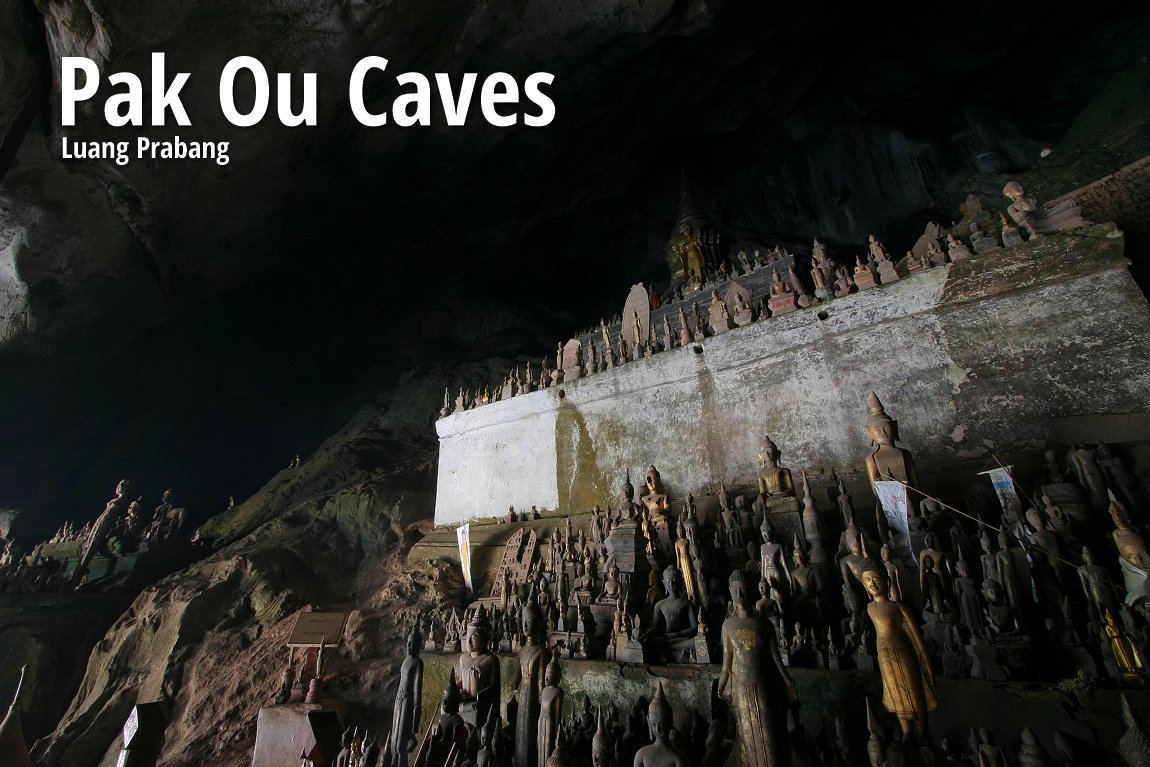 Pak Ou Caves, Luang Prabang (29 December, 2005)
Pak Ou Caves, Luang Prabang (29 December, 2005)
Pak Ou Caves refer to the set of cave system located at the confluence between the Mekong River and Nam Ou River. It is about an hour by boat on the Mekong north of Luang Prabang, and is on the left bank of the river. Although most Western guidebooks call it Pak Ou Caves, which means "Caves at the Mouth of the Ou River," to the locals it is Tam Ting Caves, meaning "Caves of a thousand Buddhas." Both, of course, are correct.
Tam Ting Caves have been in use for religious purposes from the earliest times, before Buddhism was introduced to the region. The Mekong River valley was inhabited since the middle of the 8th century. At that time, the local people worshipped the spirits of nature called Phi. Tam Ting Caves was assicuated with the river spirit. Buddhism only spread to the Mekong River valley much later. By the 16th century, Buddhism was embraced by the Lao royal family, and Tam Ting Caves received royal patronage from then until the monarchy was dissolved with the establishment of the Lao People's Democratic Republic in 1975.
Tam Ting Caves consist of two cave systems, the Lower Cave and the Upper Cave. A long flight of stairs lead steeply up the cliff towards the Lower Cave, and from there continues by the side to the Upper Cave, which is 60m above the river. As with most other visitors, we started by Lower Cave first. The Lower Cave is prominently visible from the Mekong River.
There are approximately 4000 Buddha figurines within Tam Ting Caves, of which approximately 2500 are in the Lower Cave. Many of the sculptures in Tam Ting Caves were the work of artisan under royal commission, and were created between the 18th and 20th centuries. They remind me of Pindaya Caves in Myanmar which also hold thousands of Buddha images, albeit of a totally different style.
A number of the Buddha figurines was placed there by worshippers. Most of these are carved of wood or moulded from tree resin, and then covered with red or black lacquer, and finally covered with gold leaf. There are also a few made from animal horn, bronze or ceramic.
The figurines are made in several different poses, of which three are the most common. The "Calling for Rain" pose shows a standing figure with the arms pointing downwards. The "Calling the Earth to Witness" pose depicts a seated figure with one hand extended downwards. Finally, the "Meditation" pose shows a seated figure with the hands crossed in front of it. Less common but also found here are the "Stop Arguing" pose, where the Buddha figure is standing, and has both hands extended outwards. The "Reclining Buddha" is similarly not commonly seen in the cave.
There are offerings of flowers, incense and candles on an altar closest to the entrance. Guarding the entrance are lion figures. On a platform immediately above the entrance is a sculpture of a forest hermit. There is a large stupa (or should I call it stupa-like structure) on the highest platform, and a smaller stupa on the cliff face to the south. The smaller stupa is said to hold the ashes of a recently deceased villager.
Within the Lower Cave is a small spring. The water from this spring is regarded as holy, and is used for the annual Laotian New Year ceremony.
The Upper Cave is located at the top of another long and steep flight of stairs, accessible from the Lower Cave. There is a wooden frieze enclosing the entrance of the cave, with a wooden door for visitors to enter. Beside the entrance is a sculpture of a diciple of the Buddha.
The Upper Cave extends some 54 m into the dark interior. On the left of the entry is a wooden water channel which is used for the ceremonial washing of the sculptures. The figure of a swan is on the upper end of the water trough while a dragon is on the lower end. The trough is decorated with sunflowers and other Laotian motif.
As we reach the deepest part of the cave, we can see a stupa on the raised platform, on the left. There are many more Buddha sculptures, most of these mere ten centimeter figurines while a few are as tall as one and a half meters. The place is very dark, and to take photographs, I had to mount my cameras on a tripod and use very slow shutter speed.
Upkeep of Tam Ting Caves is a constant duty. Each April, there is an annual religious ceremony where the caves are cleaned and the painted surfaces renewed. Worshippers would bring along their household Buddha figurines to be washed in the holy spring.
The Laotian government, with assistance from the Australian government embarked on a five-year conservation project to protect Tam Ting Caves. This commenced in 1992, and the work involved recording and cataloging the sculptures, rebuilding broken masonry and conserving many objects. In all, six tons of fallen debris were collected. As much as possible, the items with historic value is left intact.
Outside the caves are vendors selling souvenirs and beverages. As with so many other places I have visited, they descended on us as soon as they saw us coming. Most are friendly and not too aggresive in their selling. Some are just kids not more than ten years old. It is pitiful to see children having to work for a living.
 Latest updates on Penang Travel Tips
Latest updates on Penang Travel Tips
 Map of Roads in Penang
Map of Roads in Penang
Looking for information on Penang? Use this Map of Roads in Penang to zoom in on information about Penang, brought to you road by road.
Copyright © 2003-2025 Timothy Tye. All Rights Reserved.

 Go Back
Go Back